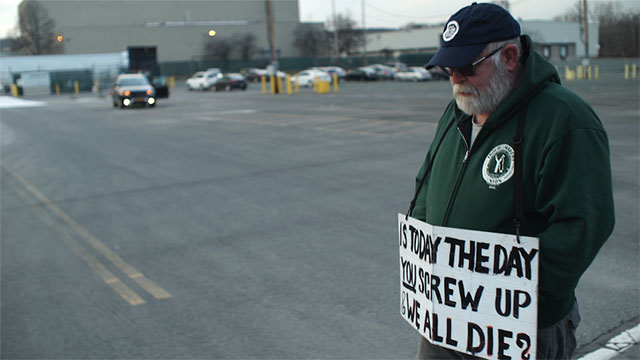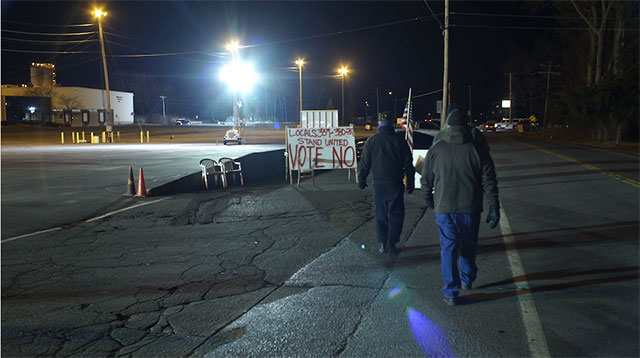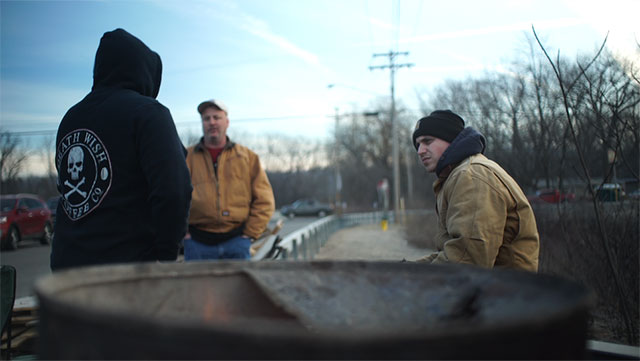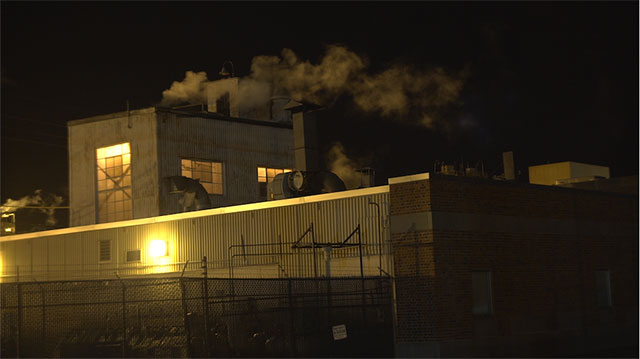
Since election night 2016, the streets of the US have rung with resistance. People all over the country have woken up with the conviction that they must do something to fight inequality in all its forms. But many are wondering what it is they can do. In this ongoing “Interviews for Resistance” series, experienced organizers, troublemakers and thinkers share their insights on what works, what doesn’t, what has changed and what is still the same. Today’s interview is the 42nd in the series. Click here for the most recent interview before this one.
The workers at the Momentive plant near Albany, New York, didn’t get as much attention in the weeks surrounding Donald Trump’s election as did those at Carrier in Indianapolis, but in many ways they are similar. While the Carrier plant was closing down, the workers there had faced repeated demands for givebacks in their contracts like the ones the Momentive workers fought against. And like Carrier, in the state from which Trump drew Vice President Mike Pence, the Momentive plant, too, had a Trump connection: Steve Schwarzman, billionaire hedge-fund titan and Trump economic adviser, had been part of the team of private equity investors who owned the plant once it was spun off from GE. Yet, when filmmaker Cecilia Aldarondo began visiting the workers on the picket line as they walked outside of Momentive for over 100 days, she found that many of them had voted for Trump. Her short film, Picket Line, is part of Our 100 Days, a short-film initiative from Firelight Media and Field of Vision examining the US after Trump. In this interview, Aldarondo discusses stereotypes of Trump voters, the power of the union in resistance, and how to talk to people on the other side of the political line drawn by the 2016 election.
Sarah Jaffe: Cecilia, you made a short film about the Momentive strike in upstate New York. For people who are listening or reading this [who] don’t know, could you tell us a little bit about that strike?
Cecilia Aldarondo: The Momentive strike actually began a week before the election of Donald Trump and lasted for a little over 100 days. There are over 700 workers who were part of the union who walked off the job, in part because Momentive had for several years been ramping up its efforts to roll back all kinds of things for unionized workers. There is a back story here, which I won’t to go into too much detail on, but suffice it to say that Momentive used to be owned by GE; and then after it became Momentive, it has gone through a series of changes and is currently owned by private equity.
Basically what that means is that over the years there has been a real distancing of management from the workers. They have really tried over the past years to try and roll back salaries, roll back vacation, roll back basically everything the workers have and erode job security in general. This is part of a longer fight. All they wanted was to keep what they had really, currently. They just didn’t want any takeaways. So they went on strike.
I am actually based in upstate New York. I live not very far away from Momentive. So, I would drive past the picket line and see these people out there 24/7. In my former life I was a labor organizer for United Auto Workers and my partner is in the labor movement, etc. So basically, after the election of Donald Trump, I felt compelled to make something. I was wanting to do something to respond to the new political reality and I just decided to go down to the picket line and start talking to people because it seemed like a good use of my time and I wanted to know what was going on in my community. In many ways, it is a local story that ties to a lot of national issues.
 A still from the film Picket Line. (Photo: Cecilia Aldarondo)
A still from the film Picket Line. (Photo: Cecilia Aldarondo)
 A still from the film Picket Line. (Photo: Cecilia Aldarondo)
A still from the film Picket Line. (Photo: Cecilia Aldarondo)
Tell us a little bit more about the process of making the film. The way you shot it with just these voices overlaying scenes on the picket line I thought was very interesting.
I really think of the film as a kind of “day in the life” portrait. To me, when I say “day in the life” I mean day and night in the life. That is because I was just really compelled — like I said, I would drive past this picket line and this was in the dead of winter. The strike began in November and wasn’t resolved until February. People were out there, literally 24 hours a day in the freezing cold, standing around these burning barrels. It felt important to me. I was really interested in conveying to the viewer what it would be like to spend a day and a night with these workers. I was trying to capture the experience of that.
To me, one of the things I think we don’t talk often enough about is not just what a union is as a conceptual idea, but what is the experience for people to actually come together and spend this kind of … time with one another collectively fighting? It is really trying to capture the texture of the meals people are eating together, the experience of warming their hands in front of the fire. That kind of stuff.
Part of it was just sort of practical. We really wanted to shoot the film relatively quickly so that it could be released relatively quickly. We thought it was a good idea to do this really pared-down “Let’s just be with the workers in their space, in the striking space, and stay there.”
 A still from the film Picket Line. (Photo: Cecilia Aldarondo)
A still from the film Picket Line. (Photo: Cecilia Aldarondo)
The area around which the Momentive strike took place was one of the places that swung several points, I think, from Obama to Trump over that four-year period. So, a lot of the workers that you talked to voted for Trump. Were you surprised to hear that? Were you kind of expecting it from the way people had already been talking about the “white working class” during the election?
Well, yes and no. In the same way that I think collectively we were sort of shocked. No one was actually expecting Trump to win. But, it didn’t take that much consideration to try and actually understand that people had swung…. Let me put it this way: I did not expect unionized workers to vote for Trump. That was something that sort of surprised me. Then, when I thought a little bit harder about it, it actually wasn’t that surprising.
What I mean by that is just thinking about this area where I live — upstate New York, in general, is a place that for many, many years was the industrialized part of the state and there are many towns, many cities even, where you can see marks of wholesale industrial decline. Momentive is located between two towns: Waterford and Mechanicville … if you drive through them, you can see signs of decline, essentially, economically. At Momentive, I would talk to people on the picket line and they would tell me about how their families and their communities, so many of them had worked at this plant that has closed and that plant that has closed.
It became clear to me over time, by talking to these people who are my neighbors, that this is basically one of the last working factories left that provides “good” jobs. What I mean by that is jobs with benefits, jobs where theoretically one person can work in a family and not be wealthy, but at least [have] a solid middle-class job. Blue-collar jobs that also give people the chance at the so-called American dream. It took some talking from me to these people, but then I was like, “Oh!” … they would tell me about their feeling completely abandoned by the left, and the right, as well. These are people who just felt totally disenchanted with party politics. They felt that Trump was honestly the only person who was speaking to them after Bernie dropped out. Many of these people were Bernie supporters who went to Trump. I think that is a really important thing to note.
Yes, and of course, the myth of the white working class and the blue-collar male worker — when we look at your film we see that is not true. You see workers who are not white. You see workers who are women. You had a really touching conversation with this one woman who works there who says that if Trump signs a national right-to-work bill she will definitely regret her vote.
One of the things that has already sort of bothered me and troubled me a little bit is in seeing how people have reacted to the film since it was released — people making knee-jerk statements about the white working class. Mostly people who think of themselves as liberal, who are rabid anti-Trumpers, who are essentially saying, “I am sick of hearing the story about the aggrieved white working class. These people are idiots,” etc. and “Thanks for screwing us over.” Something like this.
The first thing that I would say to that is, “First of all, this is not a universal…. These people are not all white” and like you said, they are not all male. I would say this area is largely white, but there were a lot of people of color that I talked to for the film. I think that these sort of bumper-sticker narratives are things that people have been clinging to to explain very complicated and much longer-running issues around the growth of economic inequality, the erosion of union power in this country, etc.
Anyway, I just want to say, this is a film that really tries to challenge those [kinds] of monolithic understandings of not just what happened, but what is happening to working people in this country. That includes all working people of all ethnicities, all genders, etc.
 A still from the film Picket Line. (Photo: Cecilia Aldarondo)
A still from the film Picket Line. (Photo: Cecilia Aldarondo)
 A still from the film Picket Line. (Photo: Cecilia Aldarondo)
A still from the film Picket Line. (Photo: Cecilia Aldarondo)
Because of the way that the voices were layered under it, you didn’t necessarily know who you are hearing talk and if it’s the same person that is on the screen.
Yes, that was a very deliberate thing. This is a collective piece in a way. I believe that the main character of the film is the union. That is very deliberate. It is a film that is trying to — a lot of documentaries tend to try and tell stories through one or two or three characters. To me, it seemed more important to think about “What does it mean that all of these people are working together?” It is the fundamental principle — I think there is a deep, deep, cynicism in the United States about unions and yet the principle of the union still stands. It is still this very basic idea that one person is not going to be able to negotiate anything with their employer or with anyone in power, but collectively that actually becomes possible.
In that sense, that is what this film is trying to essentially remind us of. It seems to be something that has been completely undermined in the United States, this idea of collective action. And yet, it seems to be the only thing we have as a resource, in a sense, right now — is our collective voice.
What did you learn from doing this film about talking to people who may have voted for Trump? Do you have advice for people who are trying to bridge those gaps right now?
Initially, after the election I said to my husband, who is an organizer, “The last thing I want to do is talk to a Trump voter.” I was saying that as a woman, I was saying that as a woman of color, I was saying that as somebody who literally just felt like “I can’t do it. That is a conversation I can’t have.” It was too painful. It was too triggering. It honestly caught me by surprise, the conversation, because like I said, I sort of naively assumed that these union people didn’t vote for Trump and I was very wrong about that. So, I found myself in that conversation and one of the things that I found myself having to do was to, first of all, stop and listen.
For me, as somebody who cared so much about what these strikers were up to, I was inclined to try and understand where they were coming from. That really helped me to stop imposing my point of view and listen to them. As a documentary filmmaker, it really wasn’t my place to try and change their minds. That actually really helped because I think that very often, that is one of the most powerful tools that an organizer or an activist or anybody who is trying to actually move the needle — the first thing people need to do is to listen to the person that they are talking to and actually respect them.
I hear a lot of people talking about Trump voters and there is that caricatured Trump voter who is usually a dude with his shirt off with a “Make America Great Again” hat on who is spouting racist things. I don’t think the vast majority of people who voted for Trump actually correspond with that stereotype. I think the first thing people need to actually do is be willing to maybe set aside some of their resentments for a second and just listen to people.
The other thing that I think is really important here…. We have this caricature of the Trump voter and, unfortunately, I think people on the left are just as guilty of simplistic thinking as people on the right sometimes and I don’t think that serves us. I think that we would get a lot further in trying to fight Trump if we actually tried to understand how people got to the thinking that they have. For example, one of the things that the Trump administration has already supported and Republicans have already introduced is national right-to-work legislation. When I would talk to workers on the picket line about this, and I would bring this up in saying, “Trump supports right-to-work,” many of them didn’t know what right-to-work was. When I explained it to them, they said, “Really? That is what right-to-work is? Oh, I don’t support that. That is terrible.” So, it wasn’t that they were stupid; it was that they didn’t know.
To me, the question becomes “How do we combat the lack of information?” To me, it is more about the fact that nobody is talking to many of these people. That is the work of grassroots organizing and advocacy. These people felt that nobody cared about them. I think that is symptomatic not of a voter’s stupidity, but it is symptomatic of a failure on the part of those people that were supposed to be trying to inform and educate and get people to vote their way.
How can people keep up with you and how can they see the film?
The film has been distributed on Fusion, but also through Field of Vision. The film is part of a series called Our 100 Days, which was commissioned by Field of Vision and Firelight Media. It is a partnership. I think all the films are really important because they chronicle a different aspect of a threat to ordinary Americans under the Trump administration. This is the second in that series. Those are releasing every Thursday on Fusion. But, this film is online on Fusion, but also on Field of Vision’s website.
Then also, I have a production company. My website is Blackscrackle Films. I made a feature film that came out last year that is actually going to be broadcast on public television this summer about my gay uncle who died of AIDS. It is [a] very different type of story. Through my website they can find out more about all of that.
Interviews for Resistance is a project of Sarah Jaffe, with assistance from Laura Feuillebois and support from the Nation Institute. It is also available as a podcast on iTunes. Not to be reprinted without permission.
Truthout Is Preparing to Meet Trump’s Agenda With Resistance at Every Turn
Dear Truthout Community,
If you feel rage, despondency, confusion and deep fear today, you are not alone. We’re feeling it too. We are heartsick. Facing down Trump’s fascist agenda, we are desperately worried about the most vulnerable people among us, including our loved ones and everyone in the Truthout community, and our minds are racing a million miles a minute to try to map out all that needs to be done.
We must give ourselves space to grieve and feel our fear, feel our rage, and keep in the forefront of our mind the stark truth that millions of real human lives are on the line. And simultaneously, we’ve got to get to work, take stock of our resources, and prepare to throw ourselves full force into the movement.
Journalism is a linchpin of that movement. Even as we are reeling, we’re summoning up all the energy we can to face down what’s coming, because we know that one of the sharpest weapons against fascism is publishing the truth.
There are many terrifying planks to the Trump agenda, and we plan to devote ourselves to reporting thoroughly on each one and, crucially, covering the movements resisting them. We also recognize that Trump is a dire threat to journalism itself, and that we must take this seriously from the outset.
After the election, the four of us sat down to have some hard but necessary conversations about Truthout under a Trump presidency. How would we defend our publication from an avalanche of far right lawsuits that seek to bankrupt us? How would we keep our reporters safe if they need to cover outbreaks of political violence, or if they are targeted by authorities? How will we urgently produce the practical analysis, tools and movement coverage that you need right now — breaking through our normal routines to meet a terrifying moment in ways that best serve you?
It will be a tough, scary four years to produce social justice-driven journalism. We need to deliver news, strategy, liberatory ideas, tools and movement-sparking solutions with a force that we never have had to before. And at the same time, we desperately need to protect our ability to do so.
We know this is such a painful moment and donations may understandably be the last thing on your mind. But we must ask for your support, which is needed in a new and urgent way.
We promise we will kick into an even higher gear to give you truthful news that cuts against the disinformation and vitriol and hate and violence. We promise to publish analyses that will serve the needs of the movements we all rely on to survive the next four years, and even build for the future. We promise to be responsive, to recognize you as members of our community with a vital stake and voice in this work.
Please dig deep if you can, but a donation of any amount will be a truly meaningful and tangible action in this cataclysmic historical moment.
We’re with you. Let’s do all we can to move forward together.
With love, rage, and solidarity,
Maya, Negin, Saima, and Ziggy